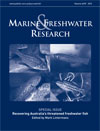
Marine and Freshwater Research
Volume 64 Number 9 2013
Recovering Australia’s Threatened Freshwater Fish
MF12306A review of on-ground recovery actions for threatened freshwater fish in Australia
Freshwater fish are increasingly imperilled, with the number of threatened species growing rapidly and considerable effort devoted to their recovery. This paper reviews the on-ground management actions directed at recovering Australian freshwater fish over the last 30+ years, with common activities documented including harvest control, translocation, habitat enhancement and stock enhancement. The strengths and weaknesses of recent recovery efforts are discussed along with the implications for future management of threatened fishes in Australia.
MF12306 Abstract | MF12306 Full Text | MF12306PDF (796 KB) | MF12306Supplementary Material (36 KB) Open Access Article
MF12252Conservation of an inauspicious endangered freshwater fish, Murray hardyhead (Craterocephalus fluviatilis), during drought and competing water demands in the Murray–Darling Basin, Australia
The Murray hardyhead is one of the most threatened freshwater fish in Australia, surviving in a handful of mostly isolated wetlands of the Murray–Darling Basin. This paper summarises the biology of Murray hardyhead, and discusses the various management actions undertaken to prevent its extinction during the recent Millennium drought. Lessons learnt from these conservation efforts can guide future conservation of aquatic biota in modified drought-prone freshwater systems.
MF12258Freshwater fish conservation in the face of critical water shortages in the southern Murray–Darling Basin, Australia
When severe drought struck the lowermost reaches of the Murray–Darling Basin, Australia, several already threatened freshwater fishes faced imminent extinction. A team of researchers, managers and community members joined forces in urgent efforts to save the fish, which included rescues, captive breeding, habitat works and environmental watering. The outcomes and lessons learned from this urgent activity will help guide local and international efforts to conserve freshwater biodiversity.
MF12262Recovery of the endangered trout cod, Maccullochella macquariensis: what have we achieved in more than 25 years?
Activities to recover the endangered trout cod have been underway for more than 25 years, guided by 3 consecutive national recovery plans. Protection from harvest through legislative controls and angler education, stocking of hatchery-bred fish, and habitat rehabilitation have been key activities in the recovery effort. Increased knowledge from an active research program, and a long-term, coordinated approach across multiple jurisdictions have been essential in reversing declines in this large, mobile, charismatic species.
MF12262 Abstract | MF12262 Full Text | MF12262PDF (458 KB) | MF12262Supplementary Material (17 KB) Open Access Article
MF12270The rise and fall of a translocated population of the endangered Macquarie perch, Macquaria australasica, in south-eastern Australia
A 32-year monitoring program has delivered a variable assessment of the success or failure of a translocation of 66 adults of the endangered Macquarie perch in south-eastern Australia. Following 5 years of non-detection, a self-sustaining population had established within 10 years, but then were again undetectable after ~25 years. Prolonged drought is thought the most likely reason for the ultimate decline, highlighting the importance of variable climate on future conservation efforts and the need for long-term monitoring.
MF12236Conservation of the endangered red-finned blue-eye, Scaturiginichthys vermeilipinnis, and control of alien eastern gambusia, Gambusia holbrooki, in a spring wetland complex
This paper discusses the conservation effort that has been directed towards red-finned blue-eye, a fish that has recently been included in a book published by the IUCN highlighting the plight of the 100 most endangered species worldwide. The work aimed to investigate whether control of gambusia was possible and whether relocation of the endangered species was a suitable population recovery technique. Both methods have been successful, and combined with other techniques it may be possible to prevent this species becoming extinct.
MF12257Extinct habitat, extant species: lessons learned from conservation recovery actions for the Pedder galaxias (Galaxias pedderensis) in south-west Tasmania, Australia
The Pedder galaxias was saved from the brink of extinction after a long and intensive program lasting in excess of thirty years. During this time many different strategies were implemented to save the fish, with translocation proving to be the most effective and beneficial. Many lessons have been learnt that can inform conservation programs for other critically endangered freshwater fish facing similar challenges and threats.
MF12260Let’s not forget the small fishes – conservation of two threatened species of pygmy perch in south-eastern Australia
Pygmy perches are much smaller relatives of Australia’s largest freshwater fish, the iconic Murray cod, but unlike their larger cousin, their presence, let alone conservation needs, is little known by the general public. This review highlights that conservation management for pygmy perches, along with many other small species that make up the majority of the Australian and global fish fauna, reflects this low level of awareness. Observations and recommendations are made for an integrated approach to the future conservation of the two pygmy perches that may also be applied elsewhere in the world.
MF12197Hydrological manipulation to assist spawning of a threatened galaxiid fish in a highland lake system
Alterations to water level regimes threaten freshwater fishes; however, suitable operation of impoundments could help manage fish populations. Water levels were purposely manipulated in a lake system during two years and this assisted spawning and recruitment of a threatened fish species (Galaxias auratus) following a prolonged drought. Given adequate ecological knowledge, hydrological manipulations can assist recovery of threatened fishes in impoundments.
MF12245Jailbreak: a fishway releases the endangered Macquarie perch from confinement below an anthropogenic barrier
Fragmentation is a major threat to freshwater fish, especially those that require movement among habitats to fulfil life history requirements. A specifically designed fishway has increased the length of stream accessible for spawning for a population of the endangered Macquarie perch in the Cotter River, Australia. The success of the fishway has proven timely because enlargement of a downstream reservoir will inundate and destroy the majority of spawning sites of this species downstream of the fishway.



